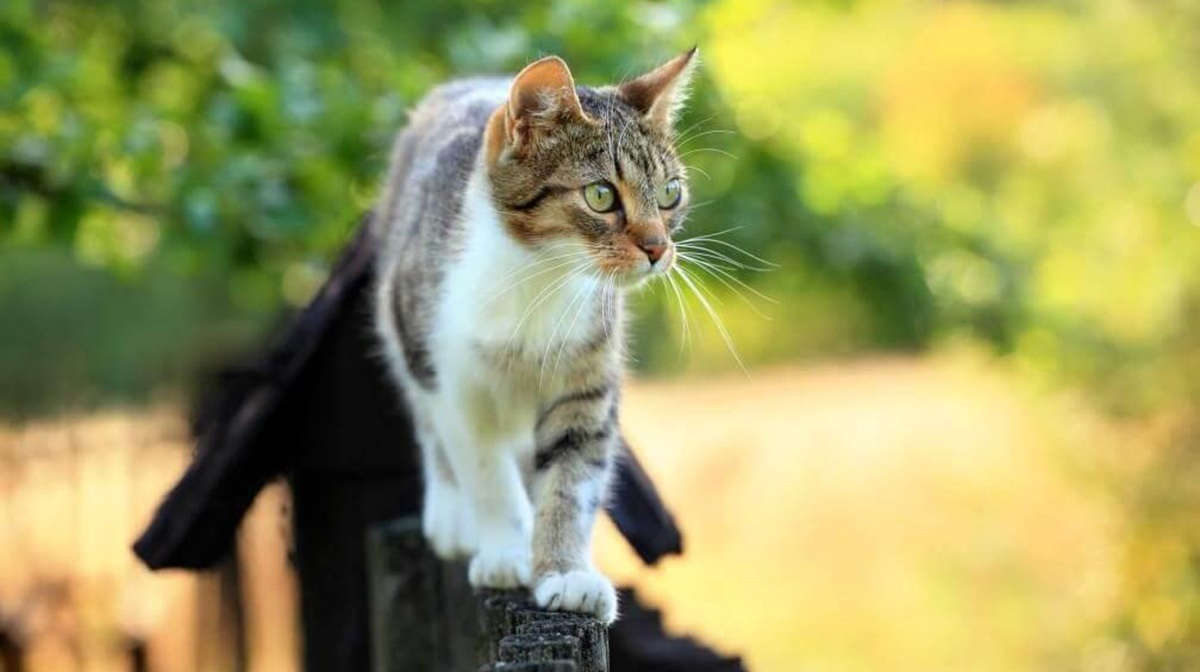
Watching our cats exploring or hunting outside makes it easier for us to understand their ancestral history as wild cats. A cat determinedly stalking a bird across the garden is definitely a fierce feline hunter rather than a domestic lap cat. One thing’s for certain – most of our feline friends love being outside. So, when are they allowed to explore the great outdoors for the first time? James Wellbeloved offers advice on the recommendations regarding letting your cat outside.
WHEN CAN CATS GO OUTSIDE?
When it comes to your cat’s first time outside, there are certain requirements that must be met first. If you have a kitten, you will not be able to let them outside until they have had the required vaccinations, at around 13-14 weeks of age. We recommend that you get your kitten microchipped when they are receiving their last vaccinations. This way, you know that they are fully covered before you let them outside. It is a legal obligation to get your dog microchipped, but it’s also a really good idea to microchip your cat in case they go missing. If you have any questions about vaccinations or microchipping, ask a vet for advice. If you have adopted an older cat, check with the original owner or rescue centre whether it has up-to-date vaccinations and a microchip, and whether in its previous home it was an outdoor cat. Most cats who were previously indoor can adapt well to an outdoor lifestyle too. For your kitten’s first time outside, you will first need to cat-proof your garden. If you have a pond, make sure that this is safely covered. Check any fencing for holes that mischievous cats might slip through. You should also check that there are no plants in your garden that may be toxic to cats. Ideally, you should get your cat used to you calling their name before letting them outside, or training them to respond to the sound of shaking their food container. This will increase the likelihood of them coming back if you can’t find them.
A CAT’S FIRST TIME OUTDOORS
Once your kitten is outside, you will need to keep a close eye on them as they explore. Kittens – and cats – are naturally curious by nature, so avoid letting them out of your sight. Your kitten will likely be nervous at first – after all, it’s a strange new world outside, with many unfamiliar sights, sounds and smells. Planning your cat’s first foray at a quieter time of day will ensure the experience is as calm as possible. Try not to crowd your kitten and remove distractions such as small children or other pets. If you have adopted an older cat, some people recommend keeping them indoors for the first few weeks. Similar to the process with a kitten, you can then gradually introduce them to your garden. Most cats adapt quickly to new surroundings and will soon establish a new territory.

KEEPING YOUR CAT SAFE OUTSIDE
To ensure your cat has regular access to the outdoors, even when you are not at home, consider installing a cat flap so they can come and go as they please. Get your cat used to coming in and out by using treats and praise as a reward. To keep your cat safe outdoors, you should also consider neutering or spaying. Not only does this prevent unexpected litters of kittens, but it also minimises the chances of your cat straying too far from your home. Neutered cats spend less time searching for a mate and are less likely to get into fights as a result, particularly tom cats. Some cat owners prefer to keep their cats indoors at night. Although cats prefer to hunt when it’s dark, sometimes they can end up fighting other cats, or other animals such as foxes. If you’d like to keep your cat in at night, ensure all windows, doors and cat flaps are safely secured before heading to bed. Cats are naturally territorial, and every cat in a neighbourhood will have their own ‘range’ which they patrol each day. It’s natural for cats to get into fights every now and again, but if you want to avoid this, consider keeping your cat confined to your garden only. You can get specific cat fencing for this, or a cat run which lets your cat explore outside whilst still being enclosed. It’s important that if a cat can get into a garden they are able to get back out again. Otherwise you may risk neighbourhood cats coming to visit and getting into a fight with your own cat. Some cat owners like their cats to wear collars, with a tag showing their phone number. If you purchase a collar for your cat, make sure it is well-fitting and secure, and has a safety release feature, so if the collar gets hooked on a branch or fence it will be easy for your cat to free themselves.
INDOOR CATS
Some owners choose not to let their cat outside. This may be because they do not have access to a garden, they live on a busy road, or their cat is a pedigree, among other reasons. Although most cats love to be outdoors, there are certain breeds of cat that are more suited to indoor life. It’s worth remembering that indoor cats need fewer calories than outdoor cats due to having lower activity levels. If you have an indoor cat, make sure to feed them a nutritionally balanced indoor cat food to meet their nutritional needs. However, cat owners should bear in mind that cats are naturally outdoor animals, so may miss out on key feline behaviours if they are kept inside. Indoor cat owners should take care to play with their cat and encourage them to practice hunting using toys, and climbing and exploring by providing shelves or cat trees to mimic an outdoor environment.

Related Articles








